Glass Painting and Decoration
-
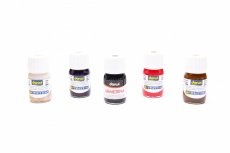 € 5.70
€ 5.70Cold Ceramic Paint Armerina 30ml
Paint suitable for stamps and stencils.
Characteristics
- Acrylic water-based paint - Ready to use
- Designed for decoration ceramics, china, tiles and glass
- 18 inter-mixable colours, 1 medium
- Very resistant to light
- Glossy when dry
- Dishwasher resistant after 48 hours drying time
- Quickly touch dry
- Non food, decorative use only
- Clean equipment with water
-
 € 5.00
€ 5.00Cold Ceramic Paint Armerina Pen
Paint suitable for stamps and stencils.
Characteristics
- Acrylic water-based paint - Ready to use
- Designed for decoration ceramics, china, tiles and glass
- 18 inter-mixable colours, 1 medium
- Very resistant to light
- Glossy when dry
- Dishwasher resistant after 48 hours drying time
- Quickly touch dry
- Non food, decorative use only
- Clean equipment with water
-
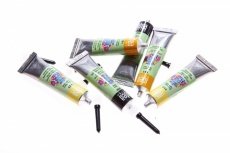 € 5.30
€ 5.30Idea Vetro Glass 20ml
Glass is synonymous with transparency, with light. Decorating glass means decorating the light that passes through it.
Alongside the better-known, more complex techniques of colouring molten glass and creating stained glass windows, there are a number of fascinating traditional techniques for colouring glass cold, recently enriched by the new potential of today's innovative materials.
Idea glass colours are solvent-based because this is the only way to guarantee outstanding stability to light and adaptability to variations in temperature, achieving unrivalled durability.
Painting on glass is traditionally as delicate and ephemeral as glass itself. At one time it was a very exclusive art, but today's synthetic resins have made it more popular, now that it is easy to paint on any glass surface, including mirrors, as well as metal and stoneware, using a variety of decorative techniques.
Idea glass colours are highly versatile, for use with techniques permitting all types of decoration by both traditional and modern methods, with no exceptions. The thirty transparent ready-to-use colours require some skill and experience for best results. The twelve water-based relief colours are soft and easy to work with, and dry rapidly. Decorating glass means building on fragility; it is a preference for intangibility, for the language of transparency.
-
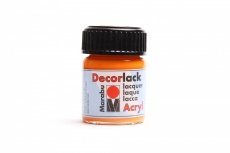 € 4.10
€ 4.10Marabu Decorlack Acrylic Paint 15ml
One lacquer for everything – the ideal, ready-to-use, high-gloss, water-based acrylic lacquer for school, hobby, leisure time, and craft use. The quality of Decorlack has been optimised to provide pleasant painting experience and exceptional coverage of many materials.
-
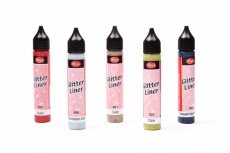 € 5.50
€ 5.50Viva Decor Glitter-Liner 25ml
The Viva Decor Glitter-Liner used to decorate objects with a precious sparkling effect. Viva Decor Glitter-Liner is bonded into its medium - very easy to use and perfectly clean to work because glass beads are embedded into the paste.
-
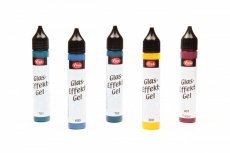 € 5.70
€ 5.70Viva Decor Glas-Effect-Gel 25ml
Totally unique and not unlike „real“ glass. Viva Decor Glass Effect Gel is transparent when dry. To achieve best results - please pay attention to the following guidelines:
- Please note: do not use „rinse-aid“ because this will impair adhesion of Viva Decor Glass Effect Gel.
- The bigger the surfaces to be decorated, the more thin coats have to be applied! Always let the coat dry completely, before subsequent applications.
- Do not dry attempt to dry Viva Decor Glass Effect Gel too fast and let your decorated work dry naturally
- for example do not use any heat source - hair dryer etc.
Important notice:
Do not apply Glass Effect Gel directly onto windows or door glass panels because Glass Effect Gel is durable and long-lasting and when dry cannot be removed.
-
 € 6.80
€ 6.803D Glitter Gel 90ml
The Viva Decor 3D Glitter Gel is a smooth paste used to decorate objects with a precious sparkling effect. Viva Decor 3 D Glitter Gel is bonded into its medium - very easy to use and perfectly clean to work because glass beads are embedded into the paste. Please note the optimum coat thickness is 1 mm and all colours are intermixable. For best results please follow the guidelines as below:
- Apply a max: coat of 1mm of Viva Decor 3D Glitter Gel –otherwise the colour may crack when drying - we also recommend pre-coating your object with a thin application of Viva Decor 3D Glitter Gel before application of the final coat however if cracks do occur you can easily rework these areas.
- Do not dry Viva Decor 3D Glitter Gel too fast and let your decorated work dry naturally - for example do not use any heat source - hair dryer etc.
-
 € 12.10
€ 12.10Idea Glitter 60ml
The term "glitter" means twinkle, sparkle, brilliance or shine.
The custom of ornamenting surfaces with fragments of glittery material is very ancient. In the middle ages precious enamel finishes were enriched with the addition of golden sparkles, and by the Renaissance there were a variety of ways of obtaining this curious, fascinating finish, so charming and mysterious. But traditional materials rarely permitted achievement of the quality possible with today's synthetic products.
Very fine flakes of polyester with a coloured mirror finish can now be mixed with any binder to anchor them solidly onto any material and create a brightly glittering surface in one or more colours. Unrivalled in light weight, durability and convenience, Idea Glitter has a very high light reflection factor which makes surfaces appear almost luminous or luminescent.
Glitter may be mixed with any binder or medium and used in any pictorial technique, applied with a brush just like paint. For an even brighter effect, apply a medium to the surface to be treated and sprinkle Glitter over it generously while it is still fresh and sticky, then leave it to dry. The polyester flakes will not come off when the medium is dry.
-
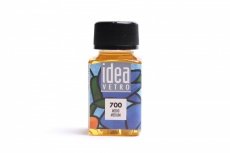 € 7.60
€ 7.60Idea Vetro Glass 60ml
Glass is synonymous with transparency, with light. Decorating glass means decorating the light that passes through it. Alongside the better-known, more complex techniques of colouring molten glass and creating stained glass windows, there are a number of fascinating traditional techniques for colouring glass cold, recently enriched by the new potential of today's innovative materials.
Idea glass colours are solvent-based because this is the only way to guarantee outstanding stability to light and adaptability to variations in temperature, achieving unrivalled durability.
Painting on glass is traditionally as delicate and ephemeral as glass itself. At one time it was a very exclusive art, but today's synthetic resins have made it more popular, now that it is easy to paint on any glass surface, including mirrors, as well as metal and stoneware, using a variety of decorative techniques.
Idea glass colours are highly versatile, for use with techniques permitting all types of decoration by both traditional and modern methods, with no exceptions. The thirty transparent ready-to-use colours require some skill and experience for best results. The twelve water-based relief colours are soft and easy to work with, and dry rapidly. Decorating glass means building on fragility; it is a preference for intangibility, for the language of transparency.
-
 € 7.60
€ 7.60Idea Ceramica 60ml
The term "ceramics", derived from the ancient Greek "Kéramos", refers to a wide variety of products obtained by modelling clay and other earths then firing them and, often, coating and decorating them. The resulting products may be grouped according to the techniques and materials used: terracotta, earthenware, majolica, stoneware and porcelain. Not all these materials can be fired again to permit the renowned technique of decoration over the enamel, so other methods and types of colour have been developed over time to permit this type of decoration to be applied cold, without firing. Idea cold ceramic colours allow professional and amateur artists and decorators to make beautiful decorated ceramics without complicated techniques and costly professional kilns.
All the colours in the range are supplied ready-to-use and are fluid, easy to use and brush on. The 20 bright, glossy colours dry quickly, may be mixed freely with one another, and may be used on glass, plastic, and metal as well as ceramic and porcelain. Thinner is available for cleaning brushes, as well as a colourless varnish which has two functions: it may be applied before painting to even out an overly porous surface or applied in an even coat all over the object to fix the painting when dry.
The product is intended exclusively for decorative use and is not recommended for use on dishes and other items for use with foodstuffs.
-
 € 7.00
€ 7.00Idea Metallic Colours Idea Metallici 60ml
When decorators need to gild certain surfaces, such as ceramic, paper or cardboard, delicate wooden surfaces or permeable surfaces, they need special metallic colours with extra resistance to oxidation and wear. Like Idea metallic colours, made of powdered metal suspended in resin. The best metallic colours are made this way, like the old shell gold. Solvent-based colours, authentic, strong and practical; long-lasting and easy to use.
Available in ten different metallic colours, which may be mixed to reproduce any kind of metal colour. All colours have good covering power if used pure and they absorb brushstrokes well. No special measures are necessary to apply the product with a brush: just make sure the surface is free of grease, sanded if too smooth, and, possibly, prepared with a base coat. May also be applied with a pad or sponge.
When painting items that will be outdoors, it is a good idea to protect this type of gilding with a thin coat of varnish to waterproof it. In this way you can obtain the smooth finish of metals without complicated procedures, using an easily applied, perfectly even colour.
-
 € 6.10
€ 6.10Idea Patina 60ml
As far back as classical antiquity poets and men of letters celebrated the colour of the noble patina which copper and bronze acquire over time. Ancient writers report that sculptures and metal objects were treated with a procedure referred to as "ganonis" which was intended to dull the overly bright sheen of newly cast metal. The patina on metals has been appreciated ever since those days. In the Middle Ages and the Renaissance techniques were devised to imitate its effects, giving rise to controversy and learned dissertation on the restoration and conservation of ancient art in the Romantic age. With the affirmation of the Neoclassical style, patina became an art; even today, creating a patina and giving metal or metal-coated objects an antique appearance is common practice in the decorative arts, continuing the tradition of surface imitation which was until recently possible only with paints and colours.
Idea Patina is a revolutionary range of products for amateur and professional use which reproduce - or rather, produce - a perfect imitation of the patina of age or alteration and oxidation of metal surfaces through natural chemical processes.
A perfect patina is generated by the chemical reaction between special salts and ultra-fine powdered bronze, copper and other metals. The authentic patina is achieved by actual transformation of the metal, not by painting. With the exception of bitumen, which is soluble in white spirit, all Patina products are water-soluble, permitting adjustment of the desired effect using the most common solvent offered by nature.